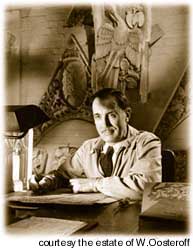His replacement, Walter G. Allen, began work in April 1917. Allen, of British origin, had previously worked restoring cathedrals in Britain. Cléophas Soucy began work in 1919 as one of Allen's carvers, eventually replacing Allen upon his retirement in 1924. The Depression years, 1929–1936, saw the position of Superintendent of the Modelling and Carving Shop sit vacant. Cléophas Soucy, who had worked on contract until 1928, sent letters to the Prime Minister and Chief Architect urging them to initiate a position of Dominion Carver. Motivated by the upcoming visit of King George VI in 1939, they hired Soucy in 1936 as the Dominion Carver, and Coeur de Lion MacCarthy as his assistant. Both men did modelling as well as carving. MacCarthy worked intermittently with Soucy who retired in 1950. Soucy specialized in the grotesque style of Gothic, embellishing the facade of the buildings with gargoyles. MacCarthy, also a professional sculptor, modelled and carved the Lion and Unicorn at the main entrance to the Parliament Buildings. By 1938 the majority of exterior carving was completed.
 Soucy
was replaced by William Oosterhoff, who had
started as Soucy's assistant in 1949. During his time as Dominion Carver,
Oosterhoff worked on Confederation Hall. His carvings were of the ornate
Gothic type. Upon his retirement, Eleanor Milne took the post of Dominion
Sculptor in 1961.
Soucy
was replaced by William Oosterhoff, who had
started as Soucy's assistant in 1949. During his time as Dominion Carver,
Oosterhoff worked on Confederation Hall. His carvings were of the ornate
Gothic type. Upon his retirement, Eleanor Milne took the post of Dominion
Sculptor in 1961.
Examples of gargoyles and grotesques may be seen on the Public Works and Government Services Canada Federal Sculptor's website about the carvings on Parliament Hill. It is called The Stones of History Carvings Gallery (external link).